10 Tips You Need For Making Perfect Chocolate Mousse
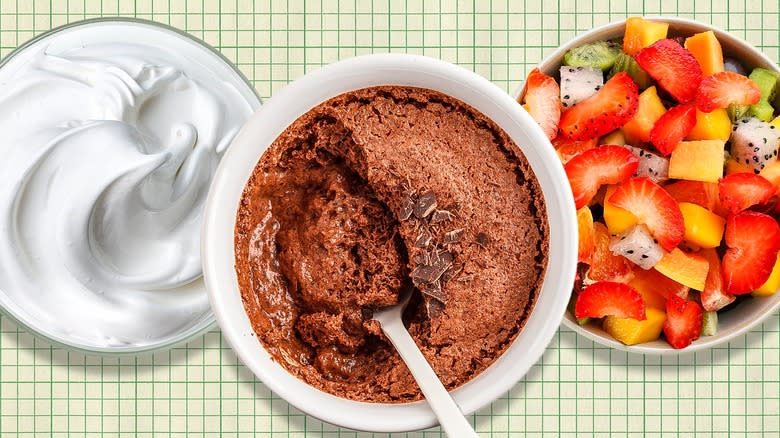
- Oops!Something went wrong.Please try again later.
Is there anything more ethereal than a perfect mousse? This dessert may seem simple at first glance, but achieving a fluffy, creamy, rich, yet airy mousse is actually quite a feat.
According to Britannica, mousse is a "savoury or sweet dish with the consistency of a dense foam, composed of a puréed chief ingredient mixed with stiffly beaten egg whites, whipped cream, or both." Its origins aren't clear, but one of its first appearances on paper is when Antoine Beauvilliers, one of the first restaurateurs in Paris, included mousse -- chocolate mousse -- in his book "L'Art du Cuisiner," published in 1814.
Regardless of its history, mousse nirvana is all about nailing the technique. The stable whip, delicate folding, and patience to let it all set will make or break your mousse — and don't worry, we've got tips if you've got a broken mousse on your hands.
We turned to two formidable pastry chefs to share the need-to-know tips to help you make the perfect mousse. Said M'Dahoma, a.k.a. The Pastry Nerd, has a PhD in Neuroscience (we promise it's not required to make great mousse) and teaches pastry and baking courses in Calgary, Canada. Saura Kline is a pastry chef at the Halcyon Hotel in Denver, a food blogger, and the author of four dessert cookbooks. With insight from these pros, the perfect chocolate mousse is only some whisking and folding away.
Read more: 25 Chocolate Brands, Ranked Worst To Best
Know The Textural Differences Between Whipped Egg Whites And Whipped Heavy Cream
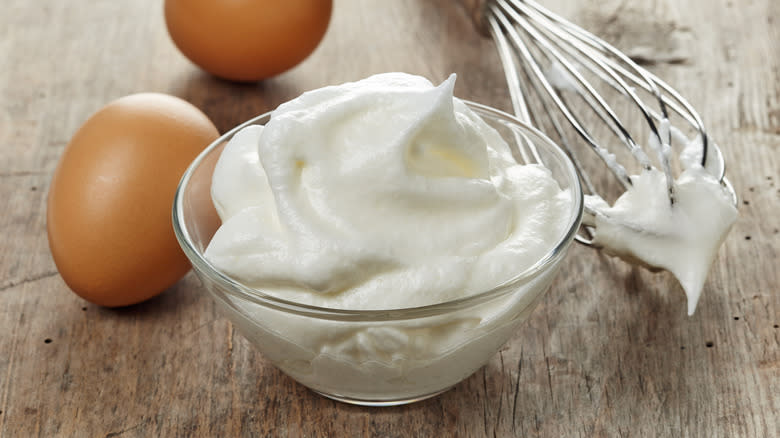
Mousses rely on foam to give them a light, fluffy texture. That lift can come from whipped egg whites (essentially a chilled meringue), whipped heavy cream, or both. Before you make your chocolate mousse, it's important to know how each foaming agent works and which to use for your desired result.
When whipping cream, the water in the cream forms a bubble around the introduced air. The fat in the cream surrounds the bubble, and the protein in the cream helps to stabilize that layer. That stability increases as the fat clumps together, which is why cream whipped to stiff peaks is thicker and firmer than cream whipped to soft peaks. If you over-whip cream, the fat continues to clump until it turns into butter.
When you whip egg whites, introduced air is trapped by proteins. Unlike in cream, any kind of fat interrupts the protein's ability to create a foam — which is why you can't whip egg whites if you've gotten any yolk in the bowl and why you need a completely clean bowl to whip in.
"An egg white-based mousse will set up very light and airy, and a cream-based mousse will be denser and creamier," says Saura Kline. Said M'Dahoma elaborates on the differences, highlighting that egg white-based mousses have a delicate texture that melts in your mouth. In contrast, a cream-based mousse has a richer consistency and more pronounced flavor with less foaminess.
Use The Right Type Of Foam For Chocolate Mousse
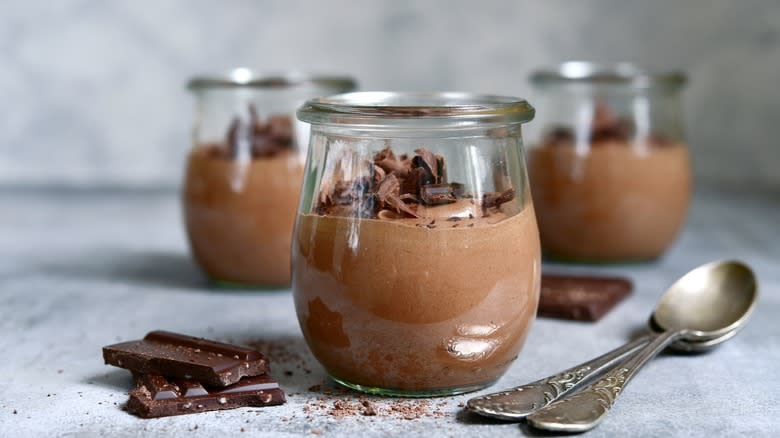
Which foam is right for your mousse: Whipped cream or whipped egg whites? Let the chocolate flavor be your guide, as the choice of foam can depend on what other ingredients you'll be using. "Chocolate mousse usually is cream-based," says Saura Kline. "A chocolate mousse will be more or less just melted [chocolate that is] then folded into whipped cream."
However, both types of foam are adaptable for chocolate mousse. Said M'Dahoma says when using whipped cream in mousse, he uses egg yolks in the base to create a custard that will provide structure. When opting for whipped egg whites instead, M'Dahoma advises whisking them until they form mid-peaks before combining them with a chocolate mixture that has added egg yolks.
Choosing the right foam also depends on how you plan to stabilize your mousse. Stabilization happens when the foam is combined with the mousse base and the mixture is cooled. Because chocolate is solid at room temperature or when chilled, chocolate mousse typically doesn't need any additional stabilizer: The cold chocolate itself firms up and traps the air bubbles. If you aren't making chocolate mousse, a stabilizer like gelatin is added to help the foam hold under the weight of the other ingredients (fruit, sugar, etc.) — especially useful for an egg white-based mousse.
Properly Prep Your Equipment And Ingredients
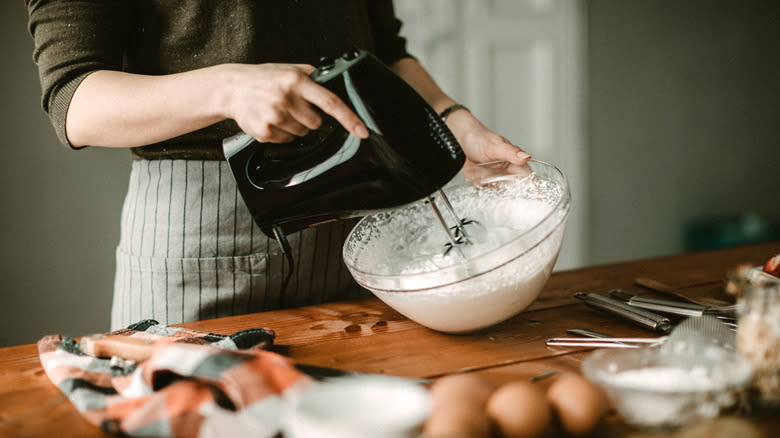
When making a mousse, mise-en-place is critical. Begin with cold ingredients. Said M'Dahoma said, "The whipping cream should be really cold before you whisk it; otherwise, it will be tough to whip it to the desired consistency." Cold cream means the fat can better trap air to create a foam, and a cold bowl will help maintain that cooler temperature. Keeping your equipment cold will also help the cream whip faster, as it will encourage the fat to solidify and stabilize the bubbles.
You can also separate your eggs while they're cold from the fridge, as it's easier when the proteins are tight, but let the egg whites get to room temperature before whipping. When the whites get warm, they become more fluid and will more readily create bubbles. As far as whipping egg whites goes, cleanliness is next to godliness. Opt for a glass, metal, or ceramic bowl, and make sure the bowl is squeaky clean. Any residue left in the bowl will prevent the egg whites from reaching their full potential, so avoid plastic (which can hold on to oil or fat in scratches on the surface).
Saura Kline also notes that you'll want your serving vessels clean and ready to go before you start cooking. Getting your mousse into the fridge right away will allow it to set up quickly and maintain the volume you've worked so hard to achieve, so don't wait to prep your dishes or ramekins.
Make Sure Your Foam Is Correctly Whipped
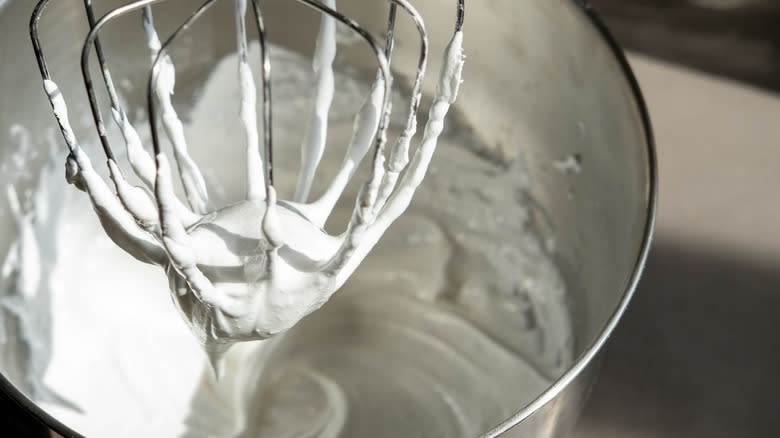
Mousse is the French word for foam, and this fluffy dessert simply wouldn't be without properly whipped egg whites or cream (or both). And that doesn't mean whipping your foam as much as possible. There's a sweet spot that gives lift while still allowing you to incorporate your flavored base and avoid a grainy final product. "The egg whites or the cream should hold by themselves but not be super stiff," says Said M'Dahoma. "One analogy I like to give to my students is that they should have the texture of shaving foam."
If you've whipped egg whites before, there's a chance you've seen what happens if you whip them too much: The foam gets so stiff that it starts to clump, dry out, and weep (the term for when the protein bonds in the foam break and the contained water escapes). According to M'Dahoma, you want to aim for medium — not stiff — peaks.
The same advice goes for whipping cream. "If it's too whipped, the mousse will be too dense," M'Dahoma explains. You also run the risk of causing the cream to separate (a nice way of saying you're on your way to making butter) — a surefire way to wind up with grainy chocolate mousse. If you notice the cream is overwhipped and starts to get lumpy, grab some more cold cream. Turn the mixer down, then slowly drizzle in the cold cream until you've got fluffy, light whipped cream again.
Add Gelatin As A Stabilizer
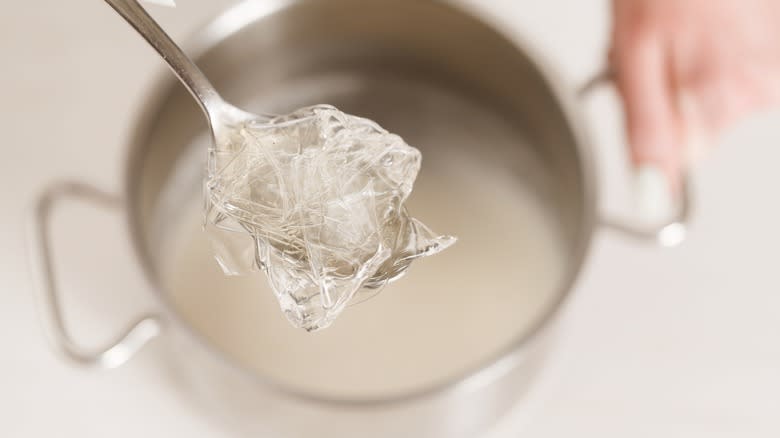
Not all mousses need gelatin, but it can be a helpful add-in. According to Saura Kline, you'll also want to use gelatin if you need your mousse to be stable enough to fill a layer cake — like, say, a dreamy decadent chocolate mousse cake.
Adding gelatin stabilizes the mousse because it introduces additional protein to your mixture — protein that will trap water and prevent the liquid elements in your mousse from running. When your mousse chills, the gelatin sets and holds tight to that liquid, giving your mousse more structure.
Choose your gelatin wisely. Powdered gelatin is easier to combine with your mousse ingredients because it dissolves quickly into cold liquid, while sheet gelatin needs to be soaked or bloomed in water before being dissolved in warm liquid. Powdered gelatin is easier to find in American supermarkets, but sheet gelatin is preferred by professional chefs. Read your recipe carefully to make sure you're using the right thing.
Because gelatin is made from animal bones, it is not vegetarian or vegan. Agar powder, derived from seaweed, is a popular vegan gelatin substitute. Chocolate mousse does not usually need a stabilizer, so it's easy to make a vegetarian version, and vegan mousse can also be made with aquafaba, tofu, or even avocado.
Incorporate Exciting Flavors To Chocolate Mousse
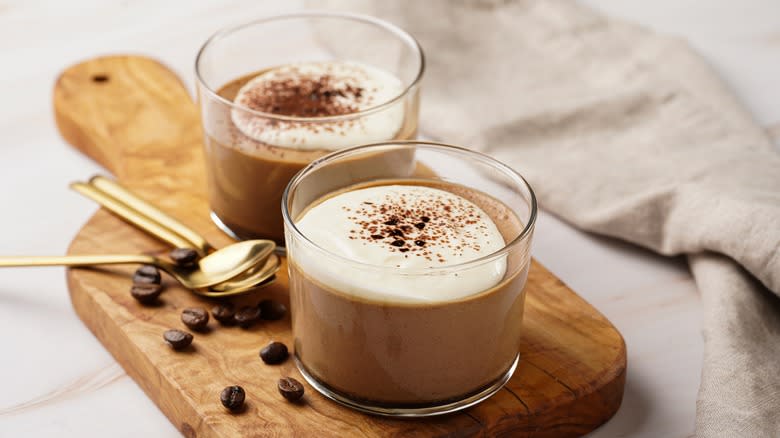
Mousse comes in any flavor imaginable (smoked salmon, anyone?), so you can amp up the chocolate mousse with anything you dream of.
Yearning for a taste of coffee? Just melt the chocolate with hot coffee. While the world is your oyster, a few fruits can throw a wrench in the mix. Enzymes in certain fruits like papaya, kiwi, and guava can prevent gelatin from setting. To avoid this issue, be sure to boil or steam the fruit to denature the enzyme, or use a canned option instead. Once you've prepped your fruits, you can make a fruit puree to add on top of the chocolate mousse or simply include fruit pieces between layers of the dessert. You can also throw in some crunchy additions like cookie bits for texture.
And yes, you can make boozy mousse, too. How delicious would an Irish Cream chocolate mousse be? Just be aware that the addition of alcohol will affect the setting process. "If you put too much [alcohol], the mousse will become very liquid," Said M'Dahoma explains. The alcohol should be added to the chocolate mixture when it is no longer hot so it doesn't evaporate entirely, and M'Dahoma recommends adding gelatin to help the mousse set.
Check For Lumps In Your Chocolate Mousse
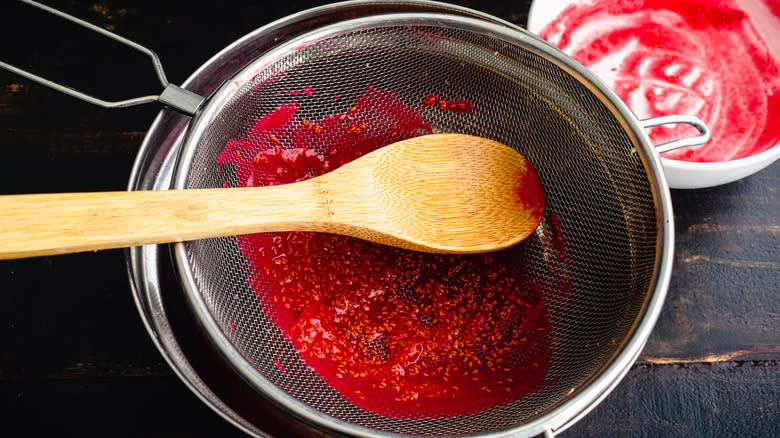
Before you combine your flavored base with your whipped cream or egg whites, check for lumps. "The important thing to keep in mind before adding your [foam] is to make sure that your chocolate is fully melted and that [your base] is well blended," says Said M'Dahoma. You shouldn't have to strain your base if everything has been properly combined. If you wound up with a few lumps of un-mixed egg yolk or spot a bit of unmelted chocolate, you can run your base through a strainer to get it nice and smooth. You'll also want to strain any bases made with fresh fruit before incorporating them to remove any seeds or pulp.
Next, check the temperature of your ingredients. "A grainy or lumpy mousse happens when you try to incorporate egg white or cream when the chocolate mixture is too cold," M'Dahoma says. The cold egg whites or cream will cause the chocolate to set and firm up (which is where the stability of chocolate mousse comes from), and if your chocolate mixture is too cool, that setting process will happen quickly, leading to streaks of solid chocolate in your mousse. M'Dahoma advises that the chocolate mixture should be around 100 degrees Fahrenheit when combined with whipped cream or egg whites.
Carefully — And Thoroughly — Incorporate Your Foam
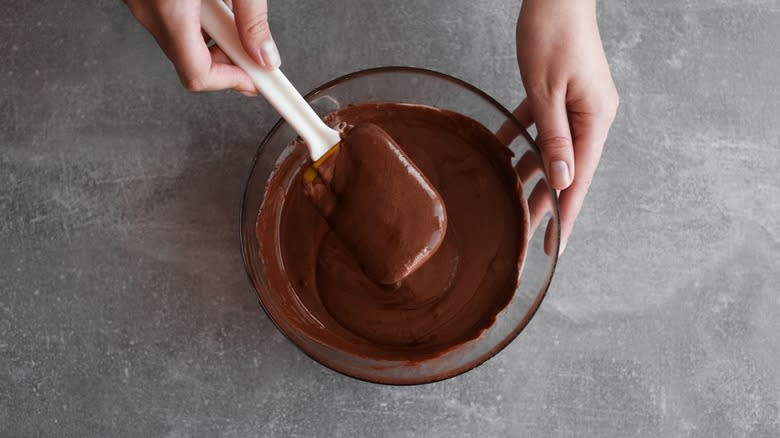
Combining your foam with your flavored base is the most crucial and technique-driven part of making a mousse. Do it right, and you'll have smooth, airy, even mousse. Do it wrong, and you'll wind up with streaks, clumps, or knock all the air out of your mousse.
Begin by adding ¼ to ⅓ of your foam to your base. Gently stir the two together until combined, lightening the base so it doesn't collapse the rest of your foam.
Next, add half of the remaining foam to your base. Scoop under the foam and base with a spatula, then lift and fold what you've scooped gently over the top. Rotate the bowl continuously until everything is combined. Finally, add the rest of the foam and repeat. Be incredibly gentle to maintain as much volume as possible while also making sure there are no streaks left.
What happens if you overdo it with the folding? Well, you'll lose a lot of lift. Over-mixed mousse can become runny, but there are a few options. Saura Kline suggests a bit of gelatin, which you can bloom and mix into your mousse before chilling and re-whipping the mixture. You can also make a liaison as a fix for runny mousse, which combines egg yolk and cream over a double boiler to create a thickening agent. Cool your liaison, mix it thoroughly into your mousse, and re-whip. It won't be quite as light as you intended, but it will still be delicious!
Go Vegan With Chocolate Mousse
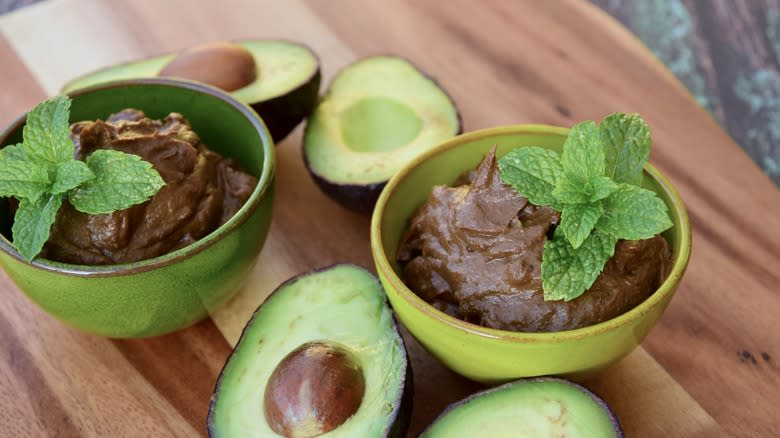
Most mousse recipes call for eggs or cream (or both), but that doesn't mean you can't enjoy mousse if you are vegan. A French chemist named Hervé This created a way to make chocolate mousse with only two ingredients: chocolate and water. High-quality chocolate is melted with water. A small amount of water would cause melted chocolate to seize, but a lot of water suspends the fat molecules instead. Whipping the melted chocolate over a bowl of ice causes the fat to cool quickly, trapping the air you add and creating a mousse that's pure chocolate. Choose a high-quality vegan couverture — not compound — chocolate with lots of cocoa butter, and you've got vegan mousse that seems like magic.
Of course, if you want a vegan mousse that's not so intense, look to tofu, coconut cream, and avocado as creamy bases. For a plant-based chocolate caramel tofu mousse, use silken tofu to provide the protein needed to create your foam. Coconut cream, a go-to vegan alternative to dairy cream, can be used for a mousse-like dessert or as a whipped topping for your vegan mousse.
While avocado is usually used in savory applications, it can also serve as the base for a creamy mousse. "I've done a great chocolate avocado mousse in a food processor," says Saura Kline. For her recipe, Kline combines avocado with cocoa powder and maple syrup, processes until light and creamy, and then chills it in ramekins before serving.
Store The Chocolate Mousse Correctly
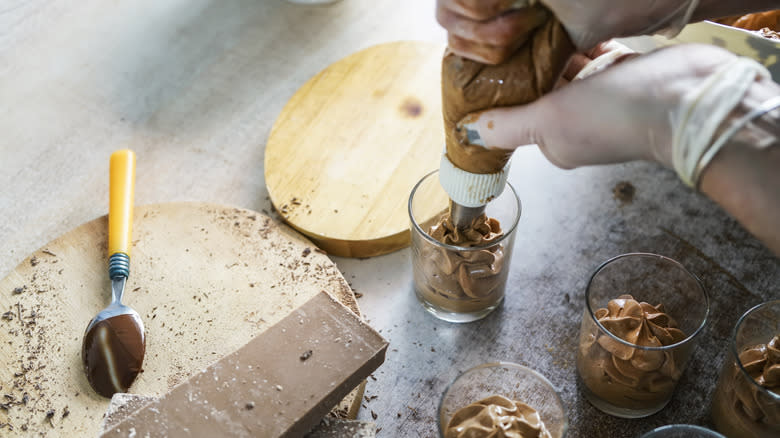
Be sure to store chocolate mousse properly if you're making it in advance. The same goes for any leftover mousse, though we can't imagine an instance where we'd have mousse leftover.
No matter what type of mousse you're making, give it time to set in the fridge before serving. Cover the mousse tightly, wrapping with plastic wrap or using an air-tight container. It will prevent the mousse from drying out, which can result in skin forming on the top.
If you aren't eating the mousse as soon as it has set, don't leave it in the fridge for too long. "Egg white-based mousse should be eaten within 24 hours as it contains raw egg [whites]," says Said M'Dahoma. A chocolate mousse made with whipped cream instead of whipped egg whites can stay in the fridge for up to 72 hours as the eggs in the base are cooked.
You can also put leftover mousse in the freezer — divide it into individual portions and wrap it tightly before freezing. When you're ready to eat, you can let the mousse defrost slowly over a few hours in the fridge. Or, enjoy the creamy, frozen goodness before it thaws since frozen mousse is somewhere between a semifreddo and frozen custard.
Read the original article on Tasting Table

